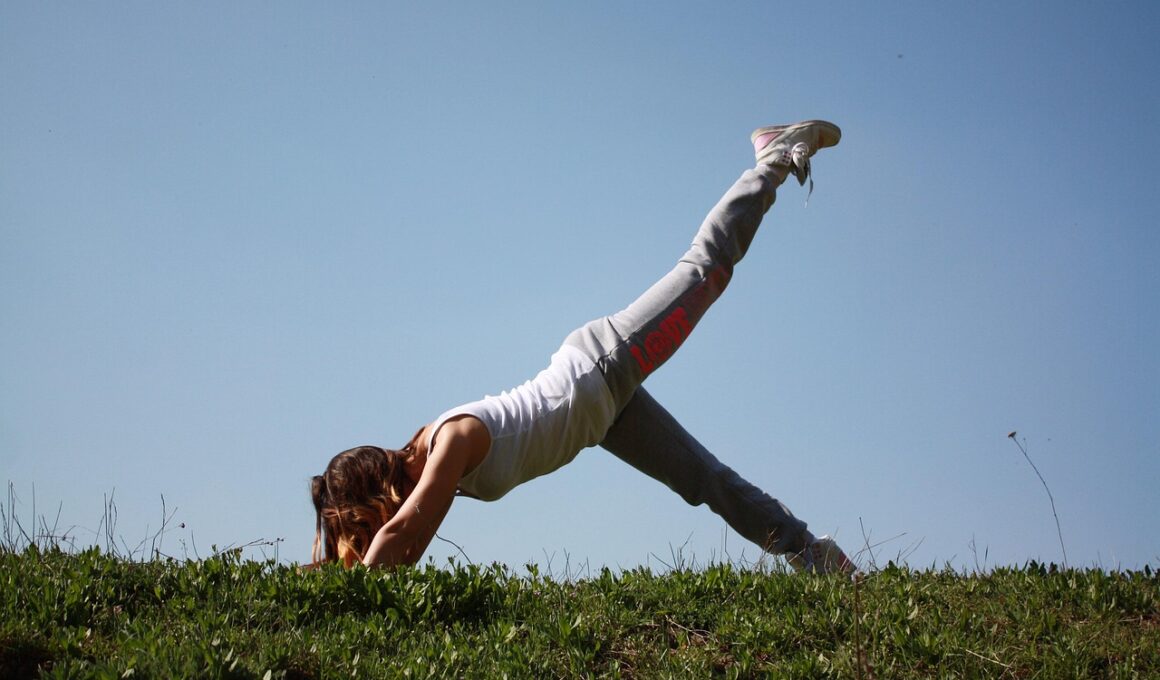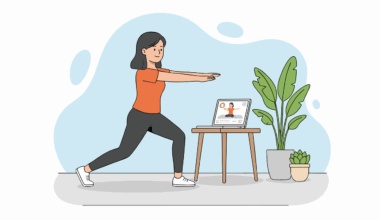The Impact of Pilates on Leg and Hip Alignment
Pilates has gained recognition as an effective method for enhancing body alignment, especially concerning the legs and hips. Rooted in the understanding of biomechanics, Pilates emphasizes core strengthening, flexibility, and controlled movements, offering practitioners a holistic approach to fitness. The routine exercises engage various muscle groups, focusing on the pelvic region, which is critical for maintaining proper alignment. Through consistent and mindful practice, individuals can experience better posture, ultimately supporting the alignment of legs and hips. Moreover, Pilates fosters awareness of body mechanics, encouraging participants to become conscious of their movement patterns. The exercises, often performed on specialized equipment or mats, can be tailored to meet different fitness levels. Through targeted movements, practitioners maintain optimal pelvic positioning, which fundamentally supports the alignment of the hips and legs. This focus on alignment reduces strain on the joints, promoting joint health and longevity. In turn, a well-aligned lower body can greatly enhance athletic performance and functional movement in daily activities.
Proper alignment of the legs and hips is crucial for overall body function and athletic performance. In Pilates classes, instructors usually emphasize specific movements that help to align these areas, thereby reducing discomfort and injury risk. For instance, exercises like the “Leg Circle” and “Single Leg Stretch” directly target the muscles surrounding the hips and legs. These exercises cultivate strength in the gluteal and abdominal muscles, providing better support for the pelvis during movement. Additionally, concentrating on muscle engagement leads to improved neuromuscular control, which is vital for maintaining balance and stability. For athletes and active individuals, focusing on leg and hip alignment can mean the difference between peak performance and injury. Furthermore, Pilates encourages slow, focused movements, allowing for the correction of any misalignment during exercise. As practitioners become more aware of their body’s position in space, they can make real-time adjustments, fostering better alignment habits even outside of the studio. Therefore, the benefits of Pilates extend beyond the mat, influencing everyday activities through improved body awareness and alignment.
The Science Behind Pilates and Alignment
Pilates is deeply rooted in the understanding of human anatomy and movement science. When examining leg and hip alignment, one must consider the intricate relationships between joints, muscles, and fascia. Pilates exercises are designed to enhance muscle control and flexibility, which directly affects alignment. Through stabilization of the core, Pilates practitioners learn to manage their pelvis more effectively, influencing leg and hip positioning. This topic is particularly significant because poor alignment can lead to issues such as knee pain or hip discomfort, both prevalent in the modern, sedentary lifestyle. A strong foundation built through Pilates can counteract these problems by enhancing overall strength and balance. The methods used in Pilates focus on engaging deeper muscles, which often go unnoticed in traditional workouts, making them essential for holistic alignment. As practitioners learn to stabilize their core, the excess strain on the hips and legs diminishes significantly, promoting healthier biomechanics. Ultimately, the science behind Pilates reveals the critical importance of adequate alignment, shaping the way individuals approach movement in their daily lives.
The role of breathing in Pilates practice significantly contributes to leg and hip alignment as well. Focusing on breath enhances engagement of the core muscles, thereby providing a solid base for movement. Each inhale and exhale is purposefully synchronized with exercise, promoting a deeper connection between body and mind. Proper breathing not only facilitates muscle engagement but also reduces tension in the body, allowing for a greater range of motion. This aspect is crucial for maintaining alignment during complex movements targeting the hips and legs. For instance, the controlled inhalation during preparatory movements can prepare the body for more demanding tasks, while exhalation facilitates the execution of movements. Furthermore, effective breathing techniques help to improve overall relaxation, which is often overlooked in movement practices. When practitioners feel tension dissipate, they can focus entirely on executing movements correctly, aiding in maintaining alignment. As individuals embrace this powerful integration within Pilates, they find improved alignment and stability across the body, allowing them to adopt more functional movement patterns. In this way, breathing becomes an essential tool for obtaining desired results.
Techniques for Enhancing Leg and Hip Alignment
Several specific Pilates techniques and exercises can be effectively used to enhance leg and hip alignment. Some foundational moves include “Bridging,” “Pelvic Tilts,” and variations of leg lifts. The “Bridge” is particularly beneficial in promoting pelvic stability, strengthening glutes while aligning the hips correctly. As one lifts the pelvis, the focus is on activating the core and gluteus muscles, which encourages an optimal alignment through the hip joints. Similarly, the “Pelvic Tilt” serves as a powerful way to encourage awareness of spine alignment, which directly influences hip positioning. Incorporating variations of leg lifts into workout routines challenges the stability of the pelvis while focusing on leg strength. Advanced exercises, like “Side Lying Leg Series,” work on lateral stability and coordination, which are crucial for achieving proper leg alignment. Plus, mindfulness in executing these exercises helps practitioners develop greater control over their movement. Each Pilates session offers delightful opportunities to build strength while nurturing the alignment of the legs and hips, ultimately contributing to long-term physical health.
Incorporating Pilates into a regular fitness routine can yield significant benefits for leg and hip alignment. For individuals with chronic pain in these areas, beginning a Pilates practice offers a gradual way to rehabilitate and regain strength. Working with a certified instructor ensures that movements are adapted based on individual needs, further enhancing safety and effectiveness. With modifications provided, those recovering from injuries can still benefit from participation, gradually introducing more intensive movements as strength returns. Alongside improved alignment, practitioners often report increased flexibility and reduced pain levels over time. As alignment improves with consistent practice, individuals notice they can achieve greater athletic performance and enhanced functional movements in day-to-day activities. The supportive community found in Pilates classes also plays a role in maintaining motivation and accountability, allowing individuals to stay committed to their alignment goals. A collaborative environment fosters a sense of belonging that further encourages personal growth, making it a fulfilling workout choice. Ultimately, Pilates doesn’t just facilitate immediate improvements; it lays the foundation for lifelong health and wellness through best practices for leg and hip alignment.
The Long-Term Effects of Pilates on Alignment
The long-term effects of a regular Pilates practice on leg and hip alignment are noteworthy. Over time, practitioners frequently express that enhanced alignment greatly affects their overall comfort and mobility. The consistent emphasis on core stability leads to a strengthened foundation from which movements are executed. Improved alignment not only reduces the risk of injury but also alleviates chronic discomfort caused by misalignment issues. In addition to physical benefits, participants frequently observe enhancements in their mental well-being, driven by the increased body awareness fostered through Pilates. Many practitioners develop a more profound relationship with their bodies, gaining insights into their individual movement patterns. This awareness translates into everyday life, allowing for better posture and more efficient movements across various activities. As individuals continue to practice, they establish a routine that promotes attentiveness to alignment, making it easier to maintain. Transitioning from focused sessions in the studio to daily interactions, the principles of Pilates encourage a more aligned way of living, ultimately enhancing quality of life. In summary, Pilates creates a sustainable impact on body structure, alignment, and overall wellness.
In conclusion, the journey of aligning the legs and hips through Pilates proves to be highly beneficial for overall health. By learning to engage the core and develop mindful movement practices, individuals enhance not only their fitness but also their everyday functioning. The various techniques taught in Pilates classes serve as tools for better alignment, alleviating discomfort and entering a path towards holistic wellness. With its emphasis on body awareness, Pilates fosters a deeper understanding of the self, empowering individuals to advocate for their health. As Pilates practitioners commit themselves to the practice, they embark on an enlightening journey of self-discovery and personal growth. The world of Pilates offers pathways to enhanced physical functioning paired with newfound mental clarity. Each breath, movement, and connection speaks to the benefits of a structured practice, ensuring alignment remains a mindful focal point. In turn, the long-lasting effects of Pilates resonate well beyond the studio, contributing to enriched lifestyles. Overall, Pilates showcases the transformative potential of movement, specifically in leg and hip alignment, leading participants towards a healthier, balanced existence.


